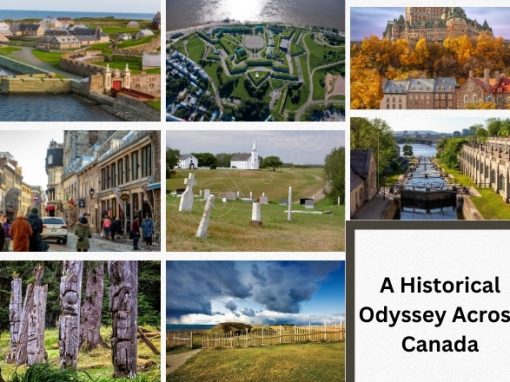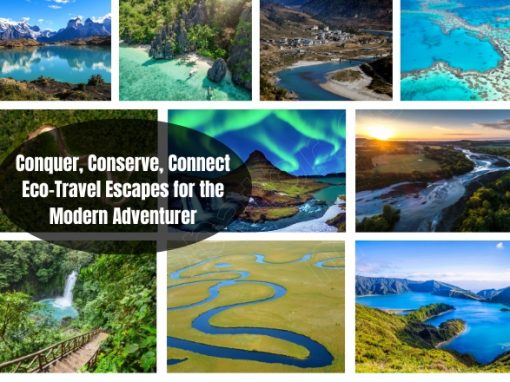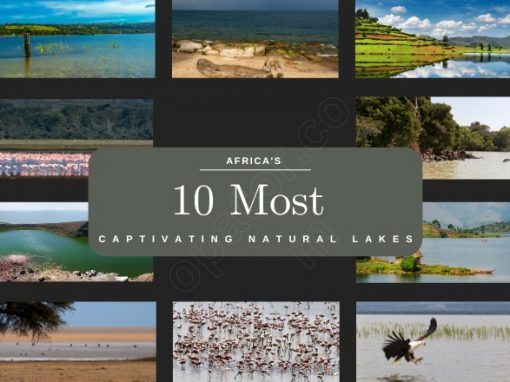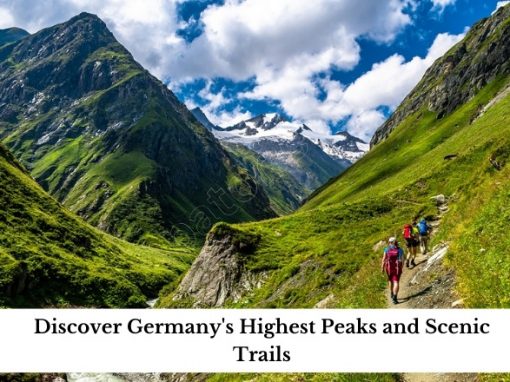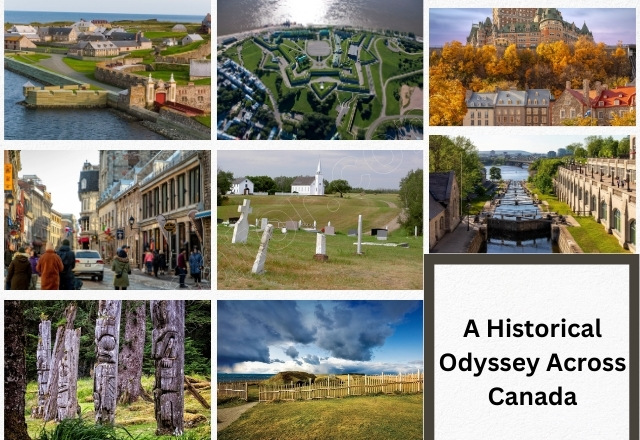
by pankaj kumar | Jun 17, 2024 | Blogs, Country/state/city, Destinations, Travel Tips
Canada, a country best known for its vast terrains and diverse cities, has a long history that is worth learning about. A visit through the historical landmarks is, therefore, important if one is to fully understand the culture of the country. Well then, grab your walking shoes, pack your questions, and let us explore together – through history!
- Fortress of Louisbourg, Nova Scotia: Visit an authentic 18th-century French fortress that was painstakingly restored to its original state. Stroll down the streets and alleys, step inside furnished homes occupied by costumed historical re-enactors, the locals. Picture soldiers exercising in the yard, hear the scent of freshly baked bread coming from the kitchen, embrace the heartbeat of times that were. See musket firing demonstrations and meet soldiers, citizens, and craftsmen who once lived in this imposing building.
- Citadel of Quebec, Quebec City: This star-shaped fort is a UNESCO World Heritage site and was strategically situated on the cliff overlooking Quebec City and the St. Lawrence River. Discover the underground tunnels that are up to 350 years old, and watch soldiers in action to demonstrate how the fort has protected Quebec City from invasions in the past. Discover more about the importance of this fortification and its contribution towards the formation of Canada.
- Old Quebec, Quebec City: Explore the essence of Europe in North America’s only walled city. Walk through a picturesque town featuring 17th-century architecture with its cafés, shops, and artists. Visit Notre-Dame Basilica that has the grand stained glass windows and high ceilings and get a feel of the old world charm. Quartier Petit Champlain is a historical area packed with shops, cafes, and street performers, also charming and unique. Here, one can buy souvenirs of regional manufacture and taste dishes of the national cuisine of Quebec.
- Old Montreal, Quebec: Colonial French influence is seen in the cobblestone roads, horse-drawn carriages, and buildings of historical significance. Visit the Notre-Dame Basilica, an excellent example of the gothic revival style of architecture, and discover the finer points of its design. Have a walk around the crowded area of the Bonsecours Market where artists and producers present their works and goods. Discover more about the city’s history at the Montreal History Centre, where visitors can touch interactives that illustrate Montreal’s past.
- Rideau Canal, Ontario: This 19th-century canal has been listed as a UNESCO World Heritage site being an important transportation artery that connected Ottawa, the capital of Canada, and Kingston. Go on a slow boat ride and see how locks and swing bridges were constructed to facilitate movements across the various water levels. Ride through the spectacular trail which borders the canal; this is a perfect way to have a quiet and serene cycling experience. Take a packed lunch with you and spend some serene time embracing the wild beauty of the area.
- Batoche National Historic Site, Saskatchewan: Travel back in time to 1885 and see the aftermath of the Métis’ rebellion. Some of them are the Métis home, the store, and the school which helps the visitors to get acquainted with the life of the Métis people during this period in the history of Canada. Discover Métis people’s rebellion against the Canadian government and extend your knowledge about the Canadian multicultural history. Visit and step on the territories where people fought for their rights and learn the stories of their fight.
- L’Anse aux Meadows, Newfoundland and Labrador: Step back in time to learn the history of the Vikings who arrived in North America around 1000 AD. Discover the secrets of this UNESCO World Heritage Site and learn about the beginnings of Canada exploration. Follow the path of these Norse sailors and try to grasp the distance they sailed across the Atlantic, and the dreams they had. For those who want to get acquainted with the Viking people better, there is a recreated Viking camp available.
- SGang Gwaay (Ninstints), British Columbia: Discover the astounding mystery of the Haida Gwaii Mortuary Poles that were erected in the eighteenth century. These carved and painted cedar giants were intended to represent family members and as a symbol of the Haida culture and art. Discover their role in the Gwaii Haanas National Park Reserve and Haida Heritage Centre. Get enthralled by the craftsmanship and meanings engraved into these colossal structures and learn more about the Haida people.
These are just some of the highlights of Canadian history. For history lovers, there is York Factory National Historic Site in Manitoba for the fur trade and Barkerville Historic Town that depicts the gold rush in British Columbia. Steam engines are exhibited in the Alberta Railway Museum for rail enthusiasts and for those interested in military, there is the Canadian War Museum in Ottawa.
Whether your history interests are antiquity, medieval, renaissance, or whatever, there’s something for you in Canada. Therefore, get ready and let the explorer in you come out by packing your bag and traveling through time across this great and diverse country. Learn Canada’s history like never before and feel the spirit of history come alive through any of the historical sites in Canada.
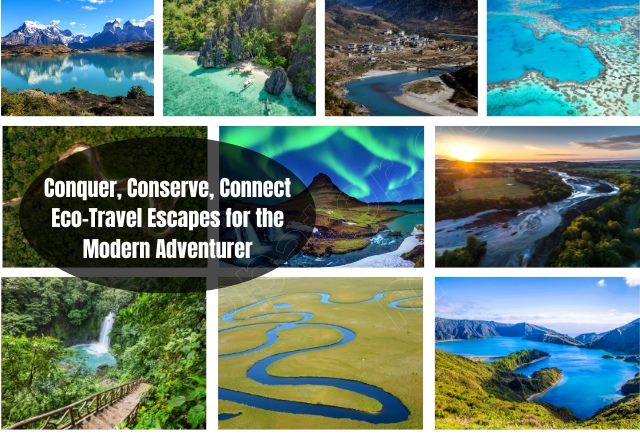
by pankaj kumar | Jun 17, 2024 | Blogs, Country/state/city, Travel, Travel Tips
The spirit of the adventurer in the present-day paradigm is not only defined by successfully climbing a mountain or navigating through a river. It is all about challenging oneself to fulfill one’s potential while taking care of the environment and making the world a better place. This new generation of adrenaline junky hunt for adventure that is both wild and environmentally responsible.
Here are a few eco-travel destinations that perfectly cater to this adventurous spirit
- Patagonia, Chile and Argentina: Trek through the famous Torres del Paine National Park, paddle between glaciers in turquoise blue lakes or go mountain biking through rugged terrain. Patagonia belongs to beginner, intermediate and advanced levels of hiking enthusiasts, but what stands out in this region is its conservation principles in tourism. Nationally parks focus on protection and there are many accommodation options including eco-friendly lodges made from natural materials.
- Palawan, Philippines: Paddle through subterranean streams, swim in the clear waters with fish around reefs, or explore caves and grottos. Palawan is a tropical paradise for adventurers, but it has serious issues, for example, deforestation and pollution. Fortunately, the idea of ecotourism is gaining increasing popularity. Tourists can buy seafood from sustainable sources, patronize establishments that provide employment to locals, and assist in trash removal from coastal areas.
- Bhutan, Himalayas: Hike through stunning landscapes of snowy mountains, meet and watch wild animals including the near-threatened black-necked crane, or visit old monasteries built atop cliffs. Bhutan also has a unique approach to tourism which is known as “High Value Low Impact Tourism’ which means that a small number of tourists are welcome and they are offered quality services that have a positive impact on the environment and community.
- The Great Barrier Reef, Australia: Join a snorkel or scuba trip to explore some of the world’s richest reef systems and an amazing array of marine creatures. Some of the threats currently facing the Great Barrier Reef include climate change and pollution. However, there are other forms of tourism that take into consideration the well-being of the reef. Tourists can decide to participate in noninvasive tours that will help conserve marine life, and get to have an insight into this balance.
- Amazon Rainforest, South America: Take a guided tour through the largest rainforest on the planet and interact with the natives and animals. The Amazon is one of the most important resources in the world, and eco-tourism helps preserve it. People can patronize indigenous-led guided tours, visit eco-friendly accommodations that do not contribute to the deforestation of the area, and be educated regarding the preservation of the rainforest.
- Iceland: Trek across glaciers, watch the beautiful colors of the Aurora Borealis paint the night sky, or relax in geothermal baths. Iceland efficiently utilizes its geothermal features in green energy production, making it a model destination for green tourism. Tourists can opt for environmentally friendly accommodations utilizing renewable energy and visit beautiful territories without disturbing natural environments.
- New Zealand’s South Island: This beautiful island country is a treasure trove of adrenaline-pumping activities that range from bungee jumping to paddling through caves inhabited by bioluminescent glow worms. But New Zealand does not stop at the adrenaline rush. Maori culture is well-represented on the South Island, and visitors get the opportunity to perform Maori dances and get acquainted with sustainable practices inherent in Maori culture. Eco-lodges and good opportunities for volunteering and contributing to the conservation of the great surrounding sceneries add value for the earth-conscious traveler.
- Costa Rica: A leader in ecotourism, Costa Rica offers adrenaline rushes and natural beauty to those who seek it. You can explore volcanoes, and rainforests full of unique wildlife, float down the rapids, or explore the caves that are not exposed to the public. Environmental conservation is an integral part of tourism in Costa Rica since it aims to protect its rainforests and other ecosystems. Tourists can be accommodated in hotels that have renewable energy sources and visit parks with a policy of environmental protection.
- Botswana’s Okavango Delta: This is a World Heritage Site according to UNESCO, and it is a perfect place for wildlife lovers. Go for a trip in a mokoro, a traditional dugout canoe, along the water channels of the delta and expect to see elephants, hippos, and literally any bird that you can imagine. Botswana has perhaps one of the most responsible tourism policies and measures to ensure the protection of wild animals and its environment. There are luxurious eco-camps that provide good accommodation without interfering much with the balance of this sensitive environment.
- The Azores, Portugal: This chain of islands located in the middle of the Atlantic Ocean is every adventurer’s dream. Activities include canyoneering through verdant canyons, surfing gigantic Atlantic waves, or enjoying a kayak cruise through secluded bays. The Azores is an environmentally conscious island with the main emphasis on marine and volcanic park conservation. There are many options for tourists to stay in environmentally friendly lodgings and contribute to the local communities’ sustainable tourism income.
These places are just a few – the globe teems with terrific secrets that provide an excellent mix of fun and sustainability. Thus, forget the popular tourist destinations, enjoy the wild spirit, and go on an unforgettable trip where your heart and adrenaline rush will help improve the world we live in.
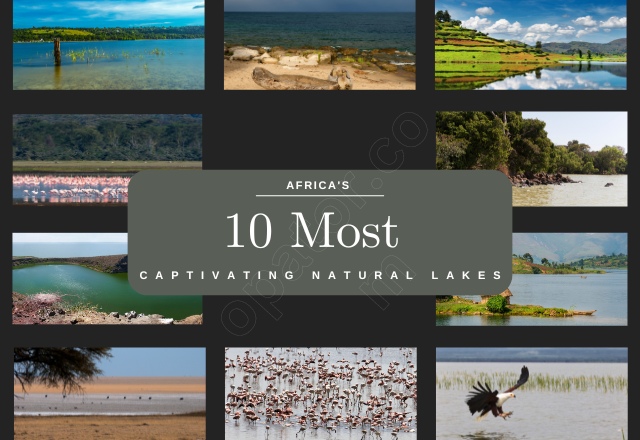
by pankaj kumar | Jun 17, 2024 | Blogs, Country/state/city, Destinations, Travel, Travel Tips
Besides vast areas of savannas and towering mountains Africa, the birthplace of humankind, has an ample number of beautiful natural lakes. These are the most important sources of water for the continent; supporting life in different forms and offering tourists amazing experiences. Here’s a deeper dive into 10 of Africa’s most captivating natural lakes
- Lake Victoria (Kenya, Tanzania, Uganda): The largest freshwater lake in Africa and the second largest in the world, Lake Victoria is known as the crown jewel of Africa. Picture yourself on a boat cruise where you come across a network of beautiful islands with colors of birds galore. You may even be lucky to spot the shoebill stork, a bird that has been listed as endangered due to its huge wingspan of more than eight feet.
- Lake Malawi (Malawi, Mozambique, Tanzania): Lake Malawi National Park is a World Heritage site attracting divers and snorkelers. Popular for various species of brightly colored cichlid fish, it boasts of its clear waters that give a real taste of a tropical fish tank. Just picture the coral gardens crowded with hundreds of species of these bright fish, every one of them different in color patterns and movements.
- Lake Bunyonyi (Uganda): Known as “The Place of Little Birds,” Lake Bunyonyi has always been a calm and serene place. The lake is inhabited by numerous islands, some of which are veiled with legends, and the possibility to relax is beyond competition. Paddle through the calm waters towards the shores of the green hills silhouetted on the water’s surface. Hear the sounds of the numerous bird species, that gave the lake its name.
- Lake Nakuru (Kenya): This Great Rift Valley’s alkaline lake is a photographer’s delight. J Just think of a moment when you can see thousands of flamingos in bright pink color feeding by the shore and what an unforgettable sight this is! Besides, the national park that surrounds the landscape accommodates many wild animals ranging from tall giraffes, powerful lions, and playful black rhinos.
- Lake Tana (Ethiopia): Located in the highlands of Ethiopia, Lake Tana is the origin of the Blue Nile, which is one of the major branches of the Nile River. Great monasteries founded on islands and ancient churches located along the coastline give a glimpse of the historical past of Ethiopia and its deeply rooted religious culture. Cruises are also an opportunity to view not only the familiar hippopotamuses but also bird species that can be found nowhere else, making the lake even more special.
- Lake Turkana (Kenya): Known as the ‘Jade Sea’ due to its greenish-blue hue, Lake Turkana is a rather unforgiving but stunning location. This lake is so far as the eye can see and it is home to birds such as flamingos, pelicans and many more. The landscape here presents an insight into the birthplace of mankind with fossils still being unearthed and the area is a blend of natural beauty and scientific history.
- Lake Kivu (Democratic Republic of the Congo, Rwanda): Located in between Rwanda and the Democratic Republic of the Congo, Lake Kivu is a sight to behold. Lying between towering volcanic ranges with steep slopes that touch the water’s edge, the lake has space for recreation on sandy shores. Savor the stunning views from the water, or go ashore to walk through the lush vegetation that surrounds the calm clear waters.
- Etosha Pan (Namibia): While it is actually a large, shallow, interior drainage depression or salt pan, Etosha Pan presents an unusual water experience. During the rainy season, water accumulates in the pan changing the scenery into a perfect photoshoot backdrop. Envision extensive plains of water, mirroring the pink fluffy clouds in the sky; the ecology of this area welcomes diverse animals such as zebras roaming the plains, springboks jumping off tall grass, and flamingos wading at the shores of the water body.
- Lake Manyara (Tanzania): This is a shallow alkaline lake in Tanzania’s Manyara National Park that is known for the lions that climb trees. Picture finding a pride of lions taking a nap in the branches of acacia trees – this is only possible in this area. The park also presents various wild animals such as elephants raising their voices, hippos sunning themselves in the mud and various colored birds flying from trees.
- Lake Baringo (Kenya): This is a freshwater lake located in the central Rift Valley region of Kenya and is a birders’ paradise. The lake is also home to over 450 species and one of them is the Baringo goose, which is a flightless bird that is also an endangered species. Cruises offer chances to observe the enormous hippos floating in the water as well as a crocodile occasionally lying on the bank. Hot springs and waterfalls also make the region beautiful besides being an important ecological area, making Lake Baringo unique.
These are just some of the many marvelous natural lakes that can be found on the African continent. Every lake is a different opportunity to be met by fascinating fauna and flora, stunning landscapes, cultural landmarks, and archaeological sites.

by pankaj kumar | Jun 17, 2024 | Blogs, Destinations, Travel, Travel Tips
Uttarakhand, blessed with the natural beauty of the Himalayas, is a fitting recipient of the title “Devbhoomi,” the Land of the Gods. Mountains that touch the sky, rivers that roll their verses of nature, and temples that narrate stories of believers—Uttarakhand is a pure pilgrimage for those who seek divine power, natural beauty, and serenity. Check out these 10 magnificent pilgrimage places in the state of Uttarakhand and the spiritual experiences that await you at each one.
- Char Dham Yatra: Experience the most spiritual journey of Hindus and visit the Char Dham Yatra. This sacred trail includes four majestic shrines, each dedicated to a different facet of the divine. Visit the origin of the Ganga at Gangotri and the Yamuna at Yamunotri. Go to the sacred shrine of Kedarnath, the temple of Lord Shiva residing in the great Himalayas. Finally, pray to Lord Vishnu in his divine abode at Badrinath. This journey is not just an act of religious devotion but an arduous journey that challenges your strength of body and mind while steeping you in Indian mythology.
- Haridwar: Often regarded as one of the seven sacred cities of Hinduism, Haridwar is the place where the holy Ganges River flows downward from the Himalayas. Experience the beautiful events of Ganga Aarti at Har Ki Pauri, which is performed during the evenings when tiny lamps float on the river, causing a sight that is both beautiful and spiritual. Take a walk through lively streets filled with temples and markets, feel the spiritual energy, and join the ceremonies that have been held on these grounds for millennia.
- Rishikesh: Situated in the lap of nature at the edge of the Himalayas, Rishikesh is known as the ‘Yoga Capital of the World’. Ancient Yoga and Meditation centers and ashrams provide an alternative way to explore the spiritual self. Performing yogasanas (postures) as old as civilization is possible here under the supervision of master trainers or just let your soul wander with the flow of your breathing by the side of the sacred river. In the evening, go for Ganga Aarti at Triveni Ghat, as the Ganges meets with two other holy rivers here which adds to the spiritual aura.
- Jageshwar: Jageshwar, nestled in the Deodar forests, has much to tell about a period that prevailed in the prehistoric time. Visit a chain of more than one hundred historical temples filled with masterful carvings and exciting stories. Stroll around the structure and be filled with awe at the design and the aesthetic of a civilization from centuries earlier. Jageshwar is not simply a series of temples; it is a glimpse into the socio-cultural legacy of the region of Uttarakhand.
- Hemkund Sahib: Go for a thrilling and adventurous tour to Hemkund Sahib, a holy Shrine of the Sikhs situated in the Himalayas. This Gurudwara is situated in the midst of imposing glaciers and colorful pastures and therefore provides breathtaking views and serenity. Step into the calm environment of this temple, which reflects the fundamentals of the Sikh religion and its values of community, worship, and tolerance. Hemkund Sahib stands as proof that faith can overcome any barriers, and this place, surrounded by stunning nature, unites different people, giving them hope and comfort.
- Tungnath: Test your adventurous soul by having a trek to Tungnath, known to be the highest temple of Lord Shiva on earth. From alpine meadows dotted with wildflowers to steep paths and ridges, experience the breathtaking vistas of the Himalayas here. Reaching the temple, which is a structure made of stones believed to be the shoulders of Lord Shiva, is a satisfying feeling. Located in one of the most scenic places in Uttarakhand, the physical activity of reaching the top and the internal atmosphere of the temple make it an awesome experience.
- Neelkanth Mahadev: Situated on a mountain slope near Rishikesh, Neelkanth Mahadev Temple attracts travelers and explorers of all kinds. The complicated trail in beautiful surroundings provides an opportunity to be with nature. When you get to the temple, which is considered the neck of Lord Shiva, admire the beauty of the area and the relative calmness of the place. The trek to Neelkanth Mahadev temple itself is quite challenging, but the view of the unparalleled beauty and religious vibes is worth it.
- Gaurikund: Gaurikund is the base camp for one of the most challenging treks to Kedarnath, the abode of Shiva. Located in Uttarakhand, in the lap of the Himalayas, Gaurikund is one of the most important pilgrimage sites for Hindus, situated at a place where Goddess Parvati is said to have meditated to win over Lord Shiva. Before starting the steep climb, take a bath in kund, the natural pool, and shiver under mountain water, leaving behind all the worldly concerns before starting the spiritual trek.
- Badrinath: Your Char Dham Yatra ends at Badrinath, which is located in the Garhwal Himalayas. Paying homage to Lord Vishnu in his manifestation as Badrinarayan, the temple of Badrinath is a marvel of architecture that has stood centuries of tests by both time and the forces of nature. Here, amidst the beauty of mountains and in the serenity of the temple and the enchanting music of the pilgrims, one feels blessed. The sight of the beautiful sunrise with peaks covered in snow and the temple changing its color to gold is certainly unforgettable.
Bonus: Valley of Flowers: Uttarakhand observes religious sites which are not simply confined to temples and pilgrimages. Visit the UNESCO World Heritage Site, famously known as the Valley of Flowers. Get lost in a sea of colors as you roam through some of the most stunning meadows with indigenous alpine flowers. The valley covered in natural beauty brings a feeling of serenity and allows one to feel the divine in the world.
Uttarakhand invites you to a spiritual journey that is beyond the realms of the physical world. It is the audacious undertaking that recharges the body, satisfies the soul, and etches on the spirit. It is time to unveil the heavenly canvas that is Uttarakhand and come to a realization about who you are within.

by Opator | May 30, 2024 | Blogs, Destinations, Travel, Travel Tips
While fairy-tale castles and dense forests are common features of the German landscape, there are spectacular mountains as well. From the snow-capped Alps to the rolling Mittelgebirge, the region has something for every type of climber and explorer. Here’s a list of the top 10 German mountain peaks and experiences to add to your bucket list:
- Zugspitze: Roof of Germany
The undisputed monarch of Germany’s highest summits is Zugspitze, which stands at a height of 2,962 meters. This magnificent colossus provides amazing views, which can be reached by cable car for tourists or by steep trails for the thrill-seekers. Reach the peak and step onto the summit of “Germany’s roof”!
- Watzmann: The Bavarian Challenge
Watzmann, the king of the Bavarian Alps, is a group of mountains having three main summits, namely Mittelspitze, Südgipfel, Hocheck, which are challenging for professional climbers. The east face remains a daunting spectacle even for persons who do not climb, although there are several walking paths crisscrossing this magnificent elevation.
- Hochwanner: Allgäu Majesty
Located in the Allgäu Alps, Hochwanner provides marvelous views of the valleys and the Zugspitze in the distance. There are several hiking options: the most beautiful and at the same time one of the most difficult is the Teufelsgrat (Devil’s Ridge). For those who do not want to hike, a cable car takes people to a viewpoint near the top of the mountain.
- Schnefernerkopf: A Climber’s Playground
Another peak close to Zugspitze, Schnefernerkopf attracts experienced climbers because of its difficult north face. But great scenery and interconnected good trails also make it a great place to hike for. Discover the fantastic scenery of the rough wilderness of Germany’s second-highest peak.
- Eibsee: Jewel of the Mountains
Although Eibsee is not a peak but rather a lake surrounded by mountains. This impressive lake lies tucked in a mountainous region and is ideal for photographers, tourists who want to take a break after climbing other mountains. You can either take a boat ride along the transparent water body or go for cycling across the villages on the lake.
- Feldberg: Black Forest Bliss
Feldberg is actually the highest mountain in the Black Forest and it attracts tourists throughout the year. During winter, people engage in skiing, and in summer, people engage in activities such as hiking and mountain biking among others. The Feldberger Steig is a steep bridle path that starts right in the middle of the Black Forest and is recommended only for experienced hikers.
- Brocken: Harz Mountain Mystery
Legend and mystery accompany the Brocken, which is the highest point of the Harz Mountains. This misty mountain peak can be reached by this old-fashioned narrow-gauge railway, which has always been interesting and captivating. Meet the flora and fauna of the mountaintop plateau nature reserve and visit the place where under certain weather conditions, a man’s shadow seems to have a giant head – the Brocken Spectre.
- Großer Arber: Bavarian Forest Family Fun
Großer Arber is also family-friendly and is located in the famous Bavarian Forest region of Germany. A cable car lifts people to the summit where they can view the scenery, trek, or enjoy a canopy bridge. Visit Bavarian Forest National Park which is full of beauty and wildlife and the ancient trees and breathe in the mountain air.
- The Rakotzbrücke (Rakotz Bridge): Devilish Delight
Although not a mountain peak itself, this curious bridge near Kromlau should not be missed by any traveler to Germany. Known as the “Devil’s Bridge,” it forms a circular reflection of the bridge on the water beneath when seen from a certain position. Visit the nearby Kromlau Rhododendron Park, a marvel of park design, and find places of interest such as waterfalls and cottages tucked into the surrounding woodlands.
- The Rheinsteig: Hiking Above the Rhine
This renowned 310-kilometer thru-hike trail runs on the east side of the Rhine River. Highlights include breathtaking views of the Rhine Valley, picturesque towns, and fascinating medieval fortresses, which makes it a great way to admire the area. Trek up through the vineyard, forest, and picturesque villages which will provide a view of the medieval castles towering over cliffs above the river.
Germany is actually replete with mountains besides the ten ones mentioned above. For instance, the Harz Mountains National Park has a well-connected system of hiking and biking trails, picturesque mountain towns like Wernigerode, and historic attractions like Quedlinburg’s medieval mountain castle. The Fichtelgebirge Mountains consist of winter sports facilities and nature parks, and the Ore Mountains are characterized by mining culture and traditional houses.
Therefore, put on your hiking shoes, pack your backpack, and get in the mood for walking through the rocky landscapes of Germany. Given the variety of terrains, steep ascents, and breathtaking views, Germany is a perfect destination for every mountaineer.

by Opator | May 30, 2024 | Blogs, House and Garden
Flower gardens are truly a wonderful oasis of spectacular colors, enchanting fragrances, and beautiful trails in a well-planned layout. From the ancient Monasteries to modern structures, these gardens capture the beauty of gardening and floral arrangement. Here’s a glimpse into 10 of the world’s most stunning flower gardens
- Keukenhof, Netherlands: Also referred to as the Garden of Europe, Keukenhof has more than 7 million flower bulbs planted on its 32 hectares. Tulips, hyacinths and daffodils come in millions and bloom beautifully in the spring season. Thinking about strolling through acres of flowers of all colors from white to red to yellow is like a painting by Monet.
- Gardens of Versailles, France: Take a trip to the Gardens of Versailles and move through time to the majestic French Baroque period. Rows of beautiful trees, well-trimmed hedges in geometrical shapes, and large, bright flower gardens stretch over 200 acres and add to the grandeur of the palace architecture. Imagine walking through smooth pavements surrounded by bushes with roses and lilies, a feeling as if you are walking back in time to the age of luxury.
- Dubai Miracle Garden, United Arab Emirates: Capture a burst of vivacious colors and artistry at the Dubai Miracle Garden. Featuring over 150 million flowers and floral creations in the shapes of animals and castles, this garden presents a colorful and diverse experience with natural beauty. Expect to see grand floral structures such as arches while flowers are laid down on the ground as carpets.
- Humble Administrator’s Garden, China: Take a trip through the history of the Humble Administrator’s Garden which has been listed under UNESCO’s World Heritage list. Established in the 16th century, the beautiful Chinese garden has ponds with Koi fish, arched bridges, pavilions, and flowers that are well arranged in a manner that they are changed to match the seasons. Picture a walk through twisting alleys, the soft string of water spewing from the fountains, and the soothing aroma of peonies blooming nearby.
- Kenroku-en, Japan: Visit one of Japan’s most famous gardens, Kenroku-en, which translates to the “Garden of the Six Substantial Things. “ Admire beautiful koi ponds that reflect the heavens, dainty bridges that overlook lovely scenes, and absorbing blossoms of different seasons. Every single item is positioned and created with the intention of bringing about this feeling of unity and order in a context that encourages tranquility.
- Butchart Gardens, Canada: Butchart Gardens is situated on Vancouver Island and it boasts of flowers virtually all through the year. Some interesting attractions that one should not miss out on are The Sunken Garden; a picturesque quarry transformed into a floral paradise with beautiful flowers in full bloom. picture walking through a number of garden-themed areas in which each represents a burst of different colors and feelings from the beautiful Rose Garden to the specially designed Japanese Garden.
- Nong Nooch Tropical Botanical Garden, Thailand: Nong Nooch offers a look into different plant species to found in the Southeast Asia region. This is a 500-hectare garden where there are beautiful gardens for bonsai trees and orchids, cactus gardens where one can find a variety of plants that exist in the desert and probably the most interesting part there are dinosaur motifs surrounded by flowers. Feel how vivacious and inviting the environment is with the gentle aroma of plumeria flowers and the sounds of unknown birds.
- Singapore Botanic Gardens, Singapore: Located in the heart of Singapore is the Singapore Botanic Gardens which features the National Orchid Garden, featuring over 70,000 orchids including 1,200 species and 200 hybrids. Founded and recognized as a UNESCO World Heritage site, visitors are taken through the tropical rain forests filled with green foliage, ginger gardens comprising of the spice of ginger lilies, and various other themes of the botanical marvels of different continents.
- Kirstenbosch National Botanical Garden, South Africa: Explore more of the nature-endowed South Africa at Kirstenbosch. Overlooking Table Mountain, which is a World Heritage site too, this garden is home to South African indigenous plants such as proteas infusing other-worldly aesthetics to the land and fynbos, a heath and shrubland containing some of the richest plant diversity in the world. There is nothing quite like admiring the majesty of the mountain while being surrounded by the beauty of the flowers and the smell of proteas and fynbos.
- Incarnate Word Chapel & Gardens, United States: Discover serenity and beauty at the Incarnate Word Chapel & Gardens in San Antonio, Texas. The chapel, which hosts functional stained glass that portrays different episodes from the bible, is well enclosed by beautiful gardens with seasonal plants and flowers perfect for meditation and prayer. Suppose one goes out for prayer in the chapel and comes out to find oneself surrounded by the soft smell of roses and the sound of a fountain.
This list only shows a few examples from all the breathtaking flower gardens of the world. Therefore, put on your comfortable shoes, expect to be amazed by floral marvels, and join this colorful journey through these marvelous creations and fantastic manifestations of people’s inspiration and the eternal gifts of nature.







